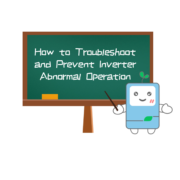How to Troubleshoot and Prevent Inverter Abnormal Operation
When an inverter experiences abnormal operation (non-shutdown failure/shutdown failure), it can result in reduced power generation in distributed PV power plants. How can we troubleshoot and prevent these issues effectively?
1. Non-Showdown Failure: Reduced/Failed Cooling Results in Lower Power Output

Operation of inverters with fans
If you observe that a fan-cooled inverter has its fan stuck by objects or the fan blades are covered in dust, the cooling efficiency will be reduced or may even fail completely. In such cases, promptly cleaning the debris from the fan is essential. Therefore, when selecting an inverter, it is recommended to select models without external fan cooling (such as the Senergy SE residential inverter series). Additionally, install the inverter in a location that is free from direct sunlight exposure, has minimal dust, and ensure good ventilation to prevent cooling failure and subsequent loss in power generation revenue.
2. Non-Showdown Failure: MPPT Failure During Inverter Operation

To verify if the inverter’s MPPT is functioning correctly, check whether the relationship between the inverter’s DC operating voltage and the MPPT channels falls within the acceptable range. Senergy SE inverters adopt self-learning MPPT technology to ensure high power generation and optimal yield from PV power plants.
3. Inverter Malfunction Due to Shutdown Failure
When any part of a PV system experiences a problem, the immediate consequence is abnormal power generation, which can even cause the inverter to stop generating power. Common faults include:
- Grid over-voltage and under-voltage (especially in rural areas with unstable grids).
- Low system insulation resistance (caused by exposed DC cables leading to insulation failure).
- Abnormal leakage current (due to improper system grounding).
- Overheating and tripping of AC/DC switches (when the switch configuration doesn’t match the system’s rated current).
- Inverter overheating, which leads to reduced output and activation of protection mode, resulting in no power generation.
Prevention Tips
When the inverter runs abnormally, prompt troubleshooting and addressing of the issues are crucial. Specific troubleshooting methods can be guided by the inverter fault code, along with explanations and recommended solutions in the user manual.
Senergy’s Smart Solar Cloud provides remote intelligent control and diagnostics, enabling quick identification and resolution of issues to restore power generation for PV power stations.




